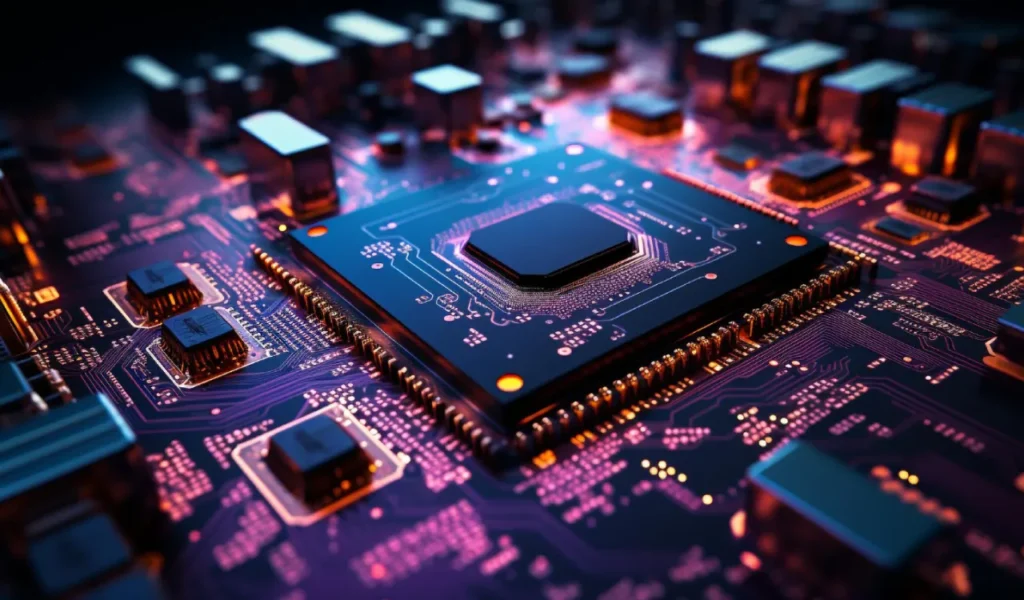Smart Manufacturing
- The electronics and manufacturing industry is undergoing a transformation
- What is Smart Manufacturing?
- Industry tailored AI
- AI’s Early Overture in the Industry
- The AI Revolution is Now on Center Stage
- The AI Revolution in Action
- Is it Helping? A resounding yes
- The Future of AI in Smart Manufacturing
- A Bright Horizon Ahead

Introduction
The electronics and manufacturing industry is undergoing a transformation led by artificial intelligence (AI). Shifting away from traditional assembly line methods, it is eagerly embracing the future. This fusion of technology and innovation is giving rise to Smart Manufacturing, a significant change that is set to redefine the industry.
What is Smart Manufacturing?
Imagine a bustling factory floor where intelligent machines hum, sensors whisper real-time data, AI algorithms decipher the murmurs, and robots and machines adapt their actions in a real-time ballet. That’s the essence of Smart Manufacturing. It’s a data-driven orchestra conducted by AI, the Internet of Things (IoT), and advanced analytics, optimizing every step of the production process, from the initial spark of design to the final curtain call of delivery.
High Tech and Electronics: An Industry Tailored for AI
The high-tech and electronics industry isn’t a monolithic entity; it’s a kaleidoscope of diverse sub-sectors, each with its unique challenges and opportunities for AI. Let’s take look at some key players:
- Semiconductors
The bedrock of modern technology, AI is optimizing chip design, minimizing defects, and streamlining production processes. Imagine AI algorithms predicting and preventing wafer imperfections, leading to up to 30% yield improvement, as demonstrated by Applied Materials’ “Envision” system. - Electronics Component
From resistors and capacitors to printed circuit boards, AI is helping manufacturers ensure consistent quality, automate assembly, and optimize inventory management. Take TE Connectivity, who uses AI-powered vision systems to detect defects in connector production, achieving near-zero error rates. - Consumer Electronics
The realm of smartphones, laptops, and wearables is being transformed by AI-driven personalization and customization. Imagine designing your dream smartphone with the help of an AI assistant, choosing everything from the materials to the processor, based on your unique needs and preferences.
AI’s Early Overture in the Industry
The seeds of AI were sown in the late 1980s, the industry’s equivalent of backstage rehearsals. Expert systems, the pioneering AI applications, took center stage, automating process control and fault detection. These initial acts laid the foundation for:
- Reduced waste
AI-powered yield prediction models stepped onto the stage, minimizing material waste by identifying potential defects before production even began. - Improved quality
Predictive maintenance systems, fueled by AI, ensured consistent product quality by preventing downtime before the curtain could fall. - Enhanced efficiency
AI-driven optimization algorithms streamlined production lines, leading to faster cycles and reduced costs, tightening the industry’s belt.
The AI Revolution is Now on Center Stage
Fast forward to today, and AI’s impact is an electrifying spectacle, fueling an array of innovations that are transforming the industry:
- Digital Twins
These virtual replicas of physical assets, powered by AI, act as understudies, constantly monitoring, predicting maintenance needs, and optimizing processes, resulting in up to 30% reduction in downtime (Accenture, 2022). - Autonomous Robots
No longer mere stagehands, AI-powered robots are handling complex tasks like assembly, inspection, and packaging, with productivity increases of up to 25% (McKinsey & Company, 2020). - Generative Design
AI-driven optimization algorithms streamlined production lines, leading to faster cycles and reduced costs, tightening the industry’s belt. - Predictive Supply Chains
AI acts as the industry’s logistics manager, forecasting demand and optimizing supply chains, reducing inventory costs by 20-30% (PwC, 2023).
The AI Revolution in Action
Beyond theoretical possibilities, AI is already driving tangible results in the high-tech and electronics industry. Here are some real-world examples:
- Samsung Electronics
Implementing AI-powered predictive maintenance across its factories, Samsung has reduced downtime by 20% and significantly extended equipment lifespans. - Siemens
Using generative design algorithms, Siemens is creating lighter, stronger aircraft components, saving airlines millions in fuel costs. - Foxconn
Employing AI-powered robots in its assembly lines, Foxconn has increased production efficiency by 15% while improving product quality.
Is it Helping? A resounding yes
The benefits of AI in smart manufacturing are undeniable, applause erupting from every corner:
- Increased productivity and efficiency
Leading to cost reductions of up to 20% (McKinsey & Company, 2020). - Improved product quality and reliability
Minimizing defects and ensuring consistent performance, eliminating unhappy audiences. - Enhanced agility and responsiveness
Enabling faster product development and customization, catering to a fickle crowd. - Sustainable practices
Optimizing energy consumption and reducing waste, bowing to environmental concerns.
The Future of AI in Smart Manufacturing: A Sneak Peek
The future of this industry is a captivating sequel, the plot brimming with possibilities:
- AI-driven factories will create 20 million new jobs globally by 2030 (World Economic Forum, 2020), welcoming a new cast of actors.
- The global smart manufacturing market will reach $512.45 billion by 2027 (Markets and Markets, 2023), the box office overflowing.
- AI-powered personalization and customization will dominate consumer electronics (Gartner, 2023), tailoring the show to individual preferences.
A Bright Horizon Ahead
The AI revolution in the high-tech and electronics industry is not merely about technological advancement; it’s about shaping a future that is efficient, sustainable, and inclusive. By harnessing the power of AI responsibly and ethically, we can ensure that this revolution benefits all stakeholders – from workers and consumers to manufacturers and the environment. As we step into this transformative era, let’s remember that AI is a tool, and its success hinges on our ability to use it for good. With responsible development and a shared vision, we can create a future where smart manufacturing empowers innovation, fosters prosperity, and paves the way for a brighter tomorrow.
